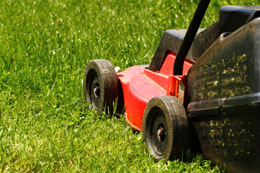When it comes to lawn weed problems, crabgrass tops the list. Here are some methods to control and prevent the growth of this weed.

Crabgrass is among the most common grass weeds. Many people do not recognize this plant and often refer to any grass weed as crabgrass. Hence, it is necessary to distinguish it from other types of grass, in order to eradicate crabgrass successfully. This weed is usually found in the warm temperate regions, and is characterized by stems that lie on the ground, with their tips growing in an ascending manner. Their light green leaves are wide and the long inflorescence has spike-like branches. The name 'crabgrass' is derived from the appearance of the stems that spread like the legs of a crab.
There are around 300 species of crabgrass, the most prominent among them being large crabgrass and smooth crabgrass. These two species are commonly found as weeds in lawns and gardens. Crabgrass can be easily distinguished by its manner of growth, which interrupts the uniform growth rate of lawn grass. Normally, the seeds of this grass germinate during the end of spring or at the onset of summer. Each plant grows in a circular manner and can reach a maximum diameter of 12 inches. As they die in the fall, crabgrass may leave gaps in your lawn, where the seeds may germinate the next season. Crabgrass can sometimes cause undergrowth of other plants or grass growing in its vicinity.
Preventive Measures
As it is difficult to eradicate this plant from your lawn or garden, it is very important to prevent their emergence and eliminate them at the earliest, as soon as they appear. The following are some measures that can be employed to prevent the emergence of crabgrass.
- Crabgrass needs sunlight for its growth. So make sure that your lawn is very healthy and thick enough to prevent any other grass from taking roots.
- Another preventive measure is to keep the mowing heights between 2½ to 3 inches. A very low mowing height means more sunlight on the ground, which can favor the growth of crabgrass.
- Water or moisture is necessary for the emergence and growth of crabgrass, so avoid frequent watering or sprinkling.
- If all these measures fail, use herbicides. A pre-emergent herbicide should be used to prevent the grass seeds from germinating. The best time for the application of this herbicide is from late April to early May, because the seeds need warmth to germinate. Make sure that the time of herbicide application does not coincide with the seeding period of the lawn grass.
These preventive measures are very important in fighting crabgrass emergence, because it is difficult to control or eradicate it, once it has spread in your lawn.
Control Measures






 Crabgrass is among the most common grass weeds. Many people do not recognize this plant and often refer to any grass weed as crabgrass. Hence, it is necessary to distinguish it from other types of grass, in order to eradicate crabgrass successfully. This weed is usually found in the warm temperate regions, and is characterized by stems that lie on the ground, with their tips growing in an ascending manner. Their light green leaves are wide and the long inflorescence has spike-like branches. The name 'crabgrass' is derived from the appearance of the stems that spread like the legs of a crab.
Crabgrass is among the most common grass weeds. Many people do not recognize this plant and often refer to any grass weed as crabgrass. Hence, it is necessary to distinguish it from other types of grass, in order to eradicate crabgrass successfully. This weed is usually found in the warm temperate regions, and is characterized by stems that lie on the ground, with their tips growing in an ascending manner. Their light green leaves are wide and the long inflorescence has spike-like branches. The name 'crabgrass' is derived from the appearance of the stems that spread like the legs of a crab.